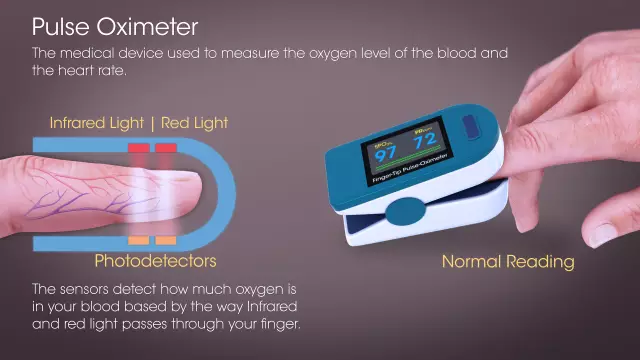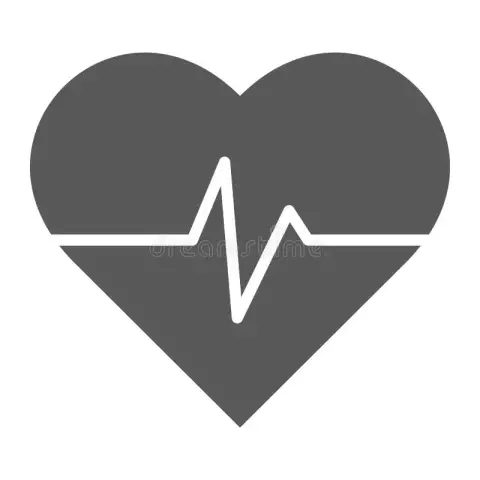- Author Rachel Wainwright [email protected].
- Public 2023-12-15 07:39.
- Last modified 2025-11-02 20:14.
How to use a pulse oximeter
One of the main dangers of coronavirus is respiratory failure. A pulse oximeter, a device for measuring the level of oxygen in the blood, will help to determine it in time and take appropriate measures. Until a few years ago, the device was only available to hospital patients. Today it can be successfully used at home. It is enough just to buy a good pulse oximeter inexpensively, and regular measurements will prevent the development of hypoxia and even save lives.

How a pulse oximeter works
All pulse oximeters record two indicators - blood oxygen saturation (saturation) and pulse rate. The data obtained are compared with the variants of the norm for certain ages, and conclusions are drawn about the state of health.
The heart pumps 7-10 thousand liters of blood per day. If it is not sufficiently saturated with oxygen, the person feels worse, the work of internal organs suffers, and the complexion worsens. Low oxygen saturation is a symptom of a number of diseases: obstructive pulmonary disease, sarcoidosis, tuberculosis, hypoxia.
The pulse oximeter, due to its ability to monitor oxygen saturation, helps to assess the functioning of the respiratory system and avoid critical conditions. The error of the indicators is estimated at no more than 1%, and the pulse measurement range is 25-250 beats per minute.
The device consists of:
- a sensor with LEDs that determine the level of oxygen in the blood;
- a microprocessor that processes the received information;
- display on which the measurement results are displayed.
LEDs emit light that penetrates tissue. The light pulsates during the measurement. The device determines the saturation by the number of these pulsations.
Heart rate monitoring is useful for people with cardiovascular and chronic respiratory diseases. In the event of an acute condition, the device helps to find out the blood counts without taking an analysis (i.e., without puncturing a finger). At the same time, the data is quickly available - in 25-50 seconds.
What are the pulse oximeters
Modern handheld pulse oximeters are small devices that are designed for home use. You can take them with you to work, rest, or visit. Depending on the configuration, they are attached to different parts of the body: forehead, finger, belly fold, forearm, earlobe. The blood condition can be monitored at any time.
All portable instruments have a memory to store the results, they can also be transferred to a computer. This is convenient, because measurements are available in dynamics, and if necessary, the data can be shown to the doctor.
A neonatal pulse oximeter is used for newborns. Its sensor is made of soft material and is put on the foot so as not to interfere with the child. Smaller devices are intended for older children. The most popular today are hand-held pulse oximeters with a sensor built into the monitor. To get data, just put your finger in a special hole and wait for the result.

How to use a pulse oximeter correctly
No special knowledge is required to use the device. To start using it, it is enough to carefully study the instructions, and also follow a number of simple rules:
- Check battery power. Most pulse oximeters are either portable or rechargeable. If the charge level is low, you need to recharge the device.
- After switching on, wait 1-2 minutes for the device to self-test.
- Attach the sensor securely to your finger (or other part of your body, depending on the type of device). The fixation should be secure, but without undue pressure. This can block blood flow and distort the result.
- Wait 5-20 seconds for the device to process the data and display the results.
Before using the device, it is recommended to cleanse the skin from impurities and do not use creams, as they can prevent the penetration of light into the tissues. So that the indicators are not affected by electromagnetic radiation, measurements are carried out away from mobile phones and household appliances.
Bright light, trembling, movement negatively affect the indicators. Therefore, during the procedure, the hand must be kept motionless, and the device itself must be placed away from sunlight and artificial lighting.
Lower saturation indicators can be:
- low body temperature;
- finger polish, false nails;
- low battery level;
- incorrect attachment of the sensor.
- tremor, arrhythmia.
Most modern devices are equipped with an auto-off function after 7-10 seconds of inactivity.
How to understand the results
The saturation rate for a healthy adult is considered to be 95-98%, with a heart rate of 60-90 beats per minute. In newborns, the pulse reaches 140 beats.
If the display shows 94% or less, it is necessary to take the measurement again, and if the result is confirmed, visit a doctor or call an ambulance.
When the device displays data below 90%, but you feel good, this indicates a malfunction, or about the individual characteristics of the body. The indicator of 100% is also a reason to think about re-measurement. Such saturation can be provoked by an abnormally low level of hemoglobin (less than 5 g / l), carbon monoxide poisoning, the presence of dyes in the blood that prevent the passage of light waves through tissues.
Constantly changing data cannot be considered correct, for example, on the monitor at first 98%, and a second check showed 91%. Most likely this indicates a malfunction of the device.
A pulse oximeter is a device for early detection of potentially dangerous conditions. By continuously measuring the level of saturation, it allows you to determine hypoxia much earlier than the doctor notices cyanosis, which is expressed in blue lips and tongue. It is the ability of early diagnosis that makes this device indispensable for many medical procedures and the successful treatment of various diseases, including complications of the coronavirus.
Found a mistake in the text? Select it and press Ctrl + Enter.






